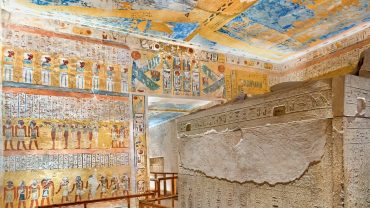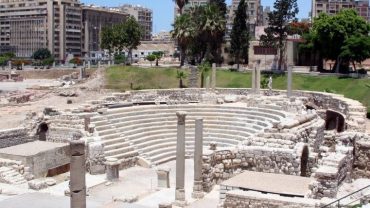Sources of The Egyptian History | Ancient Egypt Pharaonic Civilization and Mesopotamia
Sources of The Egyptian History | Primary Sources | Secondary Sources | The Egyptian Monuments | Greek Historians | Kings Lists.
Sources of The Egyptian History
What are the Sources of Egyptian history?
The Egyptian priest Manetho lived in the 3rd century BC under the reign of Ptolemy II and wrote Aegyptiaca, “the History of Egypt”. He divided Egyptian History into 30 Dynasties and this division has been taken by Egyptologists, which is divided as follows
Pre-dynastic Period
The Thinite Period
consists of the 1st and 2nd Dynasties
The Old Kingdom
include the Dynasties from the 3rd Dynasty till the 6th Dynasty
The First Intermediate Period
includes 4 Dynasties, 7th, 8th, 9th, and 10th Dynasties
The Middle Kingdom
include only two Dynasties, the 11th, and the 12thDynasties
The Second Intermediate Period
includes the Dynasties from the 13th till the 17th Dynasties
The New Kingdom
The New Kingdom of Ancient Egypt includes the 18th, 19th, and 20th Dynasties
The Third Intermediate Period
from the 21st Dynasty till the 25th Dynasty
The Late Period
from 26th Dynasty till the end of the 30th Dynasty
Sources of the Egyptian History
Primary Sources
The primary sources of Egyptian history are the sources closest to the events. Maybe texts or scenes.
Secondary Sources
Those who explain, and guess the meaning of the primary sources creates secondary sources. In other words, Historians who tell what they think about primary sources normally have conflicts, different opinions, and disagree with one another. In general, the best is the balance between the primary sources and the secondary sources.
The Egyptian Monuments
Everything the ancient Egyptians left behind them such as tombs, statutes, steles, temples like Karnak temple, Luxor temple, Edfu temple, and Philae temple. Moreover, Graffiti, coffins, Papyrus, daily life tools, and houses are considered sources of Egyptian history. Above all, the Egyptian monuments are the main source of history, it needs more studies and analysis.
The Foreign contemporary sources
These are other sources of Egyptian history as these civilizations were in contact with Egypt. For Example, the ancient near east, Assyrians, Phoenicia, and Babylon but we have to pay attention to these sources as they may represent a political point of view like the war sources, therefore should be parallel sources to certify those ones.
Greek Historians
Everyone visited Egypt in the past and wrote about it like Diodorus Siculus, Plutarch, and Strabo. The problem of this source in two points
They were written from the Greco-Roman point of view
Most of their pieces of information were received from priests and other people
Sources belonging to the Old Kingdom
Palermo stone
The name was given to a group of fragments of black basalt (7 pieces in total) carved after the end of the 5th Dynasty and it contains a set of royal annals that goes back to rulers before the beginning of Egyptian History.
Most of the stela is missing but what we have right now shows the names of the kings from the predynastic time till the early part of the 5th Dynasty. There is mention about 7 kings from the predynastic ear as following Imikhet, Wenegbu, Niheb, Tiu, Itjiesh, Khaiu, and Seka.
Those kings dating back to the dynastic era
Aha, Teti, Djer, Den, Ninetjer, Khasekhemwy, Djoser, Snoferu, Hunim Shepseskaf, Userkaf, Sahura and Neferirkara.
Does Palermo have these names (Palermo Archeological Museum)
Predynastic: Imikhet, Wenegbu, Niheb, Tiu, Itjiesh, Khaiu, and Seka
Dynastic: Sneferu, Shepseskaf
Cairo Museum has 5 fragments
Djer, Sneferu, Khufu, Djedefra, Sneferu, Khufu, Den
The text contains a summary of the events in a single year of kings. The events are religious festivals, regular taxation, the precise height of the year flood plus military campaigns.
Sources belonging to the New Kingdom – Sources of The Egyptian History
These sources date back to the New Kingdom and they were written from their point of view, so we need to compare them with parallel sources to be sure.
The Royal Lists of Saqqara
Right now, the royal list in Cairo Museum was founded in 1860 by Vicomte de Rougé and published in 1864. It was found in the Memphite tomb of a high official and scribe THENROY who lived under the reign of Ramesses II. The Royal List of Saqqara listed 58 kings in two rows of 29 kings each, in reverse chronological order, starting with Ramesses II, and going backward to Adjib.
In this Royal List the scribe THENROY praying them to grant him a share of the daily offerings which were made daily to them.
The Royal Lists of Abydos (The Abydos Canon, Abydos Table)
The list is still on the wall of the Mortuary Temple of Seti I on the right wall of the passage coming from the second Hypostyle Hall at Abydos in Egypt and it has the names of 76 ancient Egyptian Pharoah kings. King Seti I and his son Ramesses, the young prince make offerings before a list of 76 cartouches runs in six vertical columns above Ramesses. The names of the Royal List of Abydos start with king Narmer and end with Seti Himself.
The Royal Lists of Karnak
Karnak Canon or the Royal List of Karnak is not in Egypt anymore. It is in Louvre Museum, Paris after it was discovered in 1844 by the French archeologist Prisse D’ Avenne. The list was found in the southwest corner of the Akh-Menu Hall of the Temple of Amun-Re at Karnak, Egypt. The Royal List of Karnak was created in the 18th Dynasty during the reign of Thutmosis III. it listed sixty-one kings, only the names of thirty-nine kings are still legible. The list runs from Snefru down to Thutmosis III.
Turin Papyrus | Turin Kings List – Sources of The Egyptian History
This one is different from the other sources as it is not a stela, it is a Papyrus. A hieratic papyrus at the Egyptian Museum in Turin, Italy, is without a doubt the most important king list of Ancient Egypt. Turin List was discovered in 1820 and is written on the back side of a Nineteenth Dynasty of Egypt discarded administrative papyrus from the reign of Ramesses II. The Turin List contained the names of 223 kings. Of these, 126 are complete, and the remaining 97 are entirely lost. This list included the Hyksos names, although they were not given cartouches, only signs indicating that they were foreigners.

Sources Belonging to the Late Period
Texts of ancestors (Texts of descendants)
One of the most important texts dates back to the 22nd Dynasty, a priest of God Ptah knows as Cnch. f-n-skmt lived in the second half of the 8th century BC. He wrote 60 of his ancestors back in the 14th century and he mentioned some of the king’s names ruled in that time.
Sources Belonging to the Ptolemaic Period – Sources of The Egyptian History
Mantheo
An Egyptian historian and priest from Sebennytos, we do not know much about his life but we know that he was able to read Egyptian scripts and write in Greek also.
His major work was the Egyptian History called Aegyptiaca, seems he wrote it during his time at Sebennytos temple (Modern Sammanud in the Delta).
The Aegyptiaca helped establish the chronology of the pharaohs. The concept of dynasties, the grouping of a sequence of rulers based on family originated with Aegyptiaca and is still in use to this day. Manetho Aegyptiaca was lost and we know about it from the Epitomes (summaries) from rivaling advocates of Jewish, Egyptian, and Greek history.
Manetho used one name for each ruler, despite that they had to have five official names. Manetho system was used by Jean-Francois Champollion in arranging the cartouches he found from his decipherment of the ancient Egyptian language.
Other Sources (Autobiographies)
Autobiographies appeared first in the 4th Dynasty mostly in Memphis and the owners described how they built their tombs and the titles they have during their lifetime. From the 5th Dynasty, the Autobiographies were more detailed and the owners started to talk proudly about how they take care of lower social groups giving bread to hungry people, and clothes to naked people.
By the 6th dynasty, a few autobiographies appeared outside of Memphis, such as Elephantine, Edfu, and Abydos. The earliest autobiography appeared in the early 4th Dynasty by the Nomarch Methen, from Saqqara “Step Pyramid of Djoser“. while the tomb inscription of the priest Wr-Hww from Giza was the earliest statement of self-presentation with moral worthiness, which occurred near the end of the 5th Dynasty.
The Bible and the Quran
In both holly’s books, there are mentions of sites and historical events but in most cases, we cannot match dates.




Comment (0)